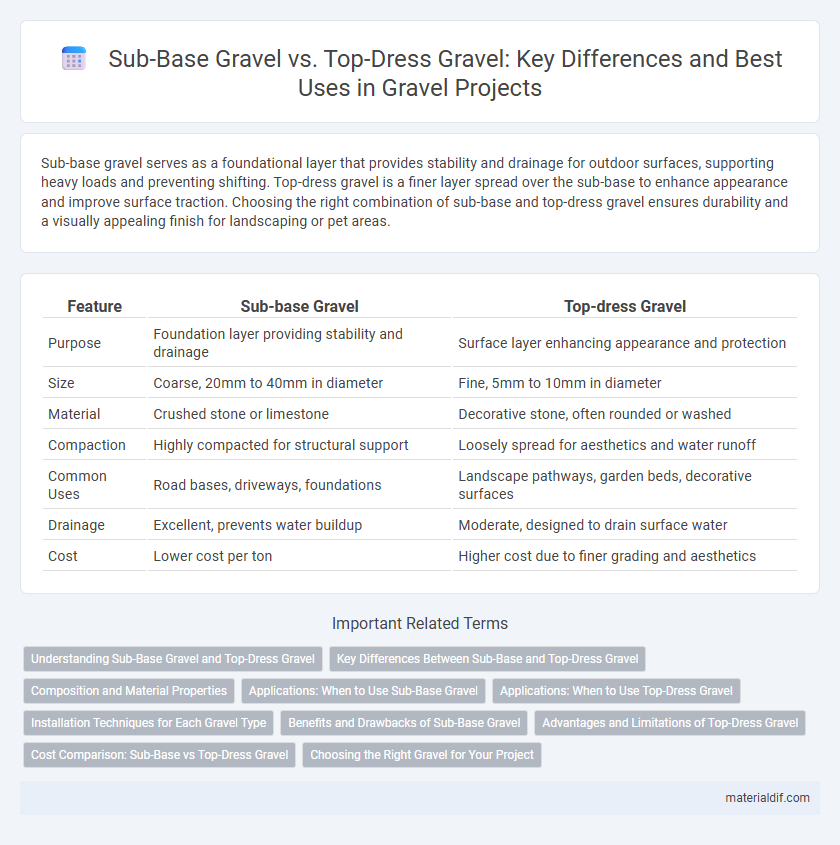Sub-base gravel serves as a foundational layer that provides stability and drainage for outdoor surfaces, supporting heavy loads and preventing shifting. Top-dress gravel is a finer layer spread over the sub-base to enhance appearance and improve surface traction. Choosing the right combination of sub-base and top-dress gravel ensures durability and a visually appealing finish for landscaping or pet areas.
Table of Comparison
| Feature | Sub-base Gravel | Top-dress Gravel |
|---|---|---|
| Purpose | Foundation layer providing stability and drainage | Surface layer enhancing appearance and protection |
| Size | Coarse, 20mm to 40mm in diameter | Fine, 5mm to 10mm in diameter |
| Material | Crushed stone or limestone | Decorative stone, often rounded or washed |
| Compaction | Highly compacted for structural support | Loosely spread for aesthetics and water runoff |
| Common Uses | Road bases, driveways, foundations | Landscape pathways, garden beds, decorative surfaces |
| Drainage | Excellent, prevents water buildup | Moderate, designed to drain surface water |
| Cost | Lower cost per ton | Higher cost due to finer grading and aesthetics |
Understanding Sub-Base Gravel and Top-Dress Gravel
Sub-base gravel, typically composed of larger, angular stones, provides a stable foundation that distributes weight evenly and enhances drainage beneath driveways or roadways. Top-dress gravel consists of smaller, smoother stones designed to create a visually appealing surface layer that minimizes erosion and improves traction. Selecting the appropriate type depending on structural needs and aesthetic preferences is essential for long-lasting, functional gravel installations.
Key Differences Between Sub-Base and Top-Dress Gravel
Sub-base gravel is a coarse, durable material used as a stable foundation layer beneath surfaces like driveways and roads, providing structural support and drainage. Top-dress gravel consists of finer, decorative aggregates applied as a surface layer to enhance appearance and reduce erosion. The key differences lie in their composition, function, and placement: sub-base gravel prioritizes stability and load distribution, while top-dress gravel focuses on aesthetics and surface protection.
Composition and Material Properties
Sub-base gravel typically consists of larger, crushed stones or recycled concrete with angular edges, providing excellent compaction and stability for foundational layers in construction. Top-dress gravel is made of finer, rounded particles such as pea gravel or decomposed granite, designed to offer smooth surface texture and effective drainage in landscaping or pathways. The composition's density and particle shape influence material properties like load-bearing capacity for sub-base gravel and aesthetic appeal for top-dress gravel.
Applications: When to Use Sub-Base Gravel
Sub-base gravel serves as a foundational layer for driveways, roads, and heavy-traffic areas, providing structural support and drainage to prevent settling and water damage. It is used beneath asphalt, concrete, or top-dress gravel to enhance durability and stability in construction projects. Choosing sub-base gravel over top-dress gravel is essential when creating a strong base layer for infrastructure requiring load-bearing capacity.
Applications: When to Use Top-Dress Gravel
Top-dress gravel is ideal for enhancing the aesthetic appeal and surface stability of driveways, walkways, and garden beds, providing a decorative finish while improving drainage and erosion control. It is best applied over a well-compacted sub-base gravel layer, which offers foundational support and load distribution for heavier traffic or structural use. Using top-dress gravel ensures a smooth, visually appealing surface suitable for light to moderate foot or vehicle traffic without compromising the underlying stability provided by the sub-base.
Installation Techniques for Each Gravel Type
Sub-base gravel installation requires precise grading and compaction to create a stable foundation that supports structures and prevents shifting. Top-dress gravel is typically spread in a thinner layer and raked evenly to enhance surface appearance and drainage without heavy compaction. Proper installation of each gravel type ensures durability, with sub-base gravel focusing on load-bearing strength and top-dress gravel prioritizing aesthetic finish and erosion control.
Benefits and Drawbacks of Sub-Base Gravel
Sub-base gravel provides a stable foundation that enhances drainage and prevents soil erosion, making it essential for road construction and heavy-load areas. Its dense compaction reduces settling and increases longevity but can be more costly and time-consuming to install compared to top-dress gravel. While sub-base gravel offers superior structural support, it lacks the aesthetic appeal and surface smoothness of top-dress gravel used for finishing layers.
Advantages and Limitations of Top-Dress Gravel
Top-dress gravel provides a smooth, attractive surface ideal for pathways and driveways, offering excellent drainage and preventing soil erosion. Its advantages include enhancing aesthetic appeal and facilitating water runoff, but it may require regular replenishment due to displacement and can become compacted over time, reducing effectiveness. Unlike sub-base gravel, top-dress gravel is not designed for structural support, limiting its use in heavy-load applications.
Cost Comparison: Sub-Base vs Top-Dress Gravel
Sub-base gravel typically costs between $30 to $50 per ton, offering a durable foundation for driveways and roads, whereas top-dress gravel ranges from $20 to $40 per ton, primarily used for surface finishing and aesthetic purposes. The price difference reflects the sub-base gravel's larger size and higher compaction requirements, ensuring stability and load-bearing capacity compared to the finer texture of top-dress gravel. Budget considerations should factor in both material costs and installation complexity, as sub-base gravel often involves more labor-intensive preparation.
Choosing the Right Gravel for Your Project
Sub-base gravel, consisting of larger, angular stones, provides a stable foundation essential for driveways, patios, and heavy-load areas, ensuring excellent drainage and pressure distribution. Top-dress gravel features finer, smoother stones that offer an attractive finish ideal for walkways, garden beds, and decorative surfaces while minimizing erosion. Selecting the right gravel depends on project requirements; prioritize sub-base gravel for structural support and top-dress gravel for aesthetic appeal and surface durability.
Sub-base gravel vs top-dress gravel Infographic

 materialdif.com
materialdif.com